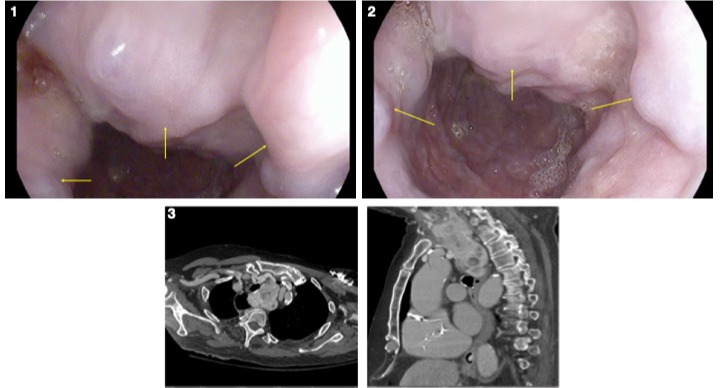Back
Poster Session D - Tuesday Morning
D0233 - An Uncommon Cause of Dysphagia in a Patient With Thyroid Disease
Tuesday, October 25, 2022
10:00 AM – 12:00 PM ET
Location: Crown Ballroom

Michael G. Noujaim, MD, MSc
Duke University Medical Center
Durham, NC
Presenting Author(s)
Michael G. Noujaim, MD, MSc1, Annapoorani Veerappan, MD2
1Duke University Medical Center, Durham, NC; 2Duke University School of Medicine, Durham, NC
Introduction: An 88-year-old man was seen for evaluation of an abnormal barium swallow in the setting of yearlong dysphagia to solids with globus sensation.
Case Description/Methods: His medical history included atrial fibrillation and hyperthyroidism. He had undergone transesophageal echocardiography, notable for difficulty in passing the probe. Consequently, we performed an upper endoscopy that showed large, non-bleeding varices extending 11 cm (proximal third) to 32 cm from the incisors (middle third) (Figure 1 and 2). The gastroesophageal junction was noted at 40 cm from the incisors. A subsequent computed tomography scan with angiography of his chest showed substernal extension of a large goiter into the middle mediastinum causing mass effect and collateralization arising from the left brachiocephalic vein creating upper esophageal varicosities (Figure 3). The patient was referred to surgical endocrinology for further management.
Discussion: Proximal esophageal varices, termed downhill varices, are usually seen in the setting of benign or malignant superior vena cava obstruction (SVCO). The upper and mid esophageal veins drain into the azygous and innominate veins. The presence of a SVCO leads to the collateralization of the azygous and innominate veins to divert venous return from the head and mediastinum. This collateralization and increased pressure lead to the development of downhill varices. Treatment of downhill varices is aimed at correcting the cause of the obstruction.

Disclosures:
Michael G. Noujaim, MD, MSc1, Annapoorani Veerappan, MD2. D0233 - An Uncommon Cause of Dysphagia in a Patient With Thyroid Disease, ACG 2022 Annual Scientific Meeting Abstracts. Charlotte, NC: American College of Gastroenterology.
1Duke University Medical Center, Durham, NC; 2Duke University School of Medicine, Durham, NC
Introduction: An 88-year-old man was seen for evaluation of an abnormal barium swallow in the setting of yearlong dysphagia to solids with globus sensation.
Case Description/Methods: His medical history included atrial fibrillation and hyperthyroidism. He had undergone transesophageal echocardiography, notable for difficulty in passing the probe. Consequently, we performed an upper endoscopy that showed large, non-bleeding varices extending 11 cm (proximal third) to 32 cm from the incisors (middle third) (Figure 1 and 2). The gastroesophageal junction was noted at 40 cm from the incisors. A subsequent computed tomography scan with angiography of his chest showed substernal extension of a large goiter into the middle mediastinum causing mass effect and collateralization arising from the left brachiocephalic vein creating upper esophageal varicosities (Figure 3). The patient was referred to surgical endocrinology for further management.
Discussion: Proximal esophageal varices, termed downhill varices, are usually seen in the setting of benign or malignant superior vena cava obstruction (SVCO). The upper and mid esophageal veins drain into the azygous and innominate veins. The presence of a SVCO leads to the collateralization of the azygous and innominate veins to divert venous return from the head and mediastinum. This collateralization and increased pressure lead to the development of downhill varices. Treatment of downhill varices is aimed at correcting the cause of the obstruction.

Figure: Figures 1 and 2 show three columns of large varices extending from the proximal third to the middle third of the esophagus. Figure 3 shows two representative computed tomography scan slices in the axial and sagittal planes highlighting the mass effect leading to compression of the right brachiocephalic vein with collateralization. This also shows the mass effect compressing the left brachiocephalic vein with collateralization.
Disclosures:
Michael Noujaim indicated no relevant financial relationships.
Annapoorani Veerappan indicated no relevant financial relationships.
Michael G. Noujaim, MD, MSc1, Annapoorani Veerappan, MD2. D0233 - An Uncommon Cause of Dysphagia in a Patient With Thyroid Disease, ACG 2022 Annual Scientific Meeting Abstracts. Charlotte, NC: American College of Gastroenterology.
